The Correlation Between Communication Preferences & Social Anxiety
Face-to-Face Communication Versus Online Communication:
The Correlation Between Communication Preferences and Social Anxiety
Katherine Leonard
The University of Texas at Austin
1. INTRODUCTION
We conducted a study that focused on people’s preferred method of communication. We specifically focused on determining if there is a correlation between a person’s preferred medium of communication and the level of social anxiety they have. We chose to explore this route because new methods of online communication pop up every year challenging us to keep up to date with these methods to ensure we are communicating to the best of our ability. Because of this, we were interested in seeing if the new methods of non-face-to-face interaction have been a tool for people with social anxiety, and we aren’t the only people seeing this potential connection.
1.1 LITERATURE REVIEW
Several studies have been conducted in the past that have also explored the correlation between online modes of communication and social anxiety.
Social anxiety and technology: Face-to-face communication versus technological communication among teens Pierce (2009) studied 280 high school students and determined that these students would often turn to their digital devices to help them navigate their social anxiety. This study gave us a good foundation to start with by confirming that there was a correlation with students in a similar age group 10 years ago. We felt that revisiting this topic 10 years later would be incredibly beneficial because we would be able to study students who have likely been immersed in online communication even more frequently than those students in the previous study.
Social anxiety, attributes of online communication and self-disclosure across private and public Facebook communication Green et al. (2016) looked at how Facebook can help people with social anxiety. This study involved 306 participants whose mean age was 20.52 to see how they use Facebook and why. They ultimately determined that Facebook provides several services that could help people with social anxiety connect with the world around them. This study helped us reaffirm that people with social anxiety do prefer some parts of online communication while also encouraging us to look at other aspects of online communication to see if there were modes that did a better job at catering to people with social anxiety.
1.2 RESEARCH QUESTION, VARIABLES, & HYPOTHESIS
After confirming that other researchers were making connections between social anxiety and online forms of communication, we wanted to further explore those connections. We asked: is there a relationship between the use of electronic communication and social anxiety when compared to face-to-face communication?
We set the medium we use to communicate with as the independent variable and the level of self-reported anxiety we collected as the dependent variable. The medium we use to communicate can be defined as online versus face-to-face communication. We recognize that there are many forms of online communication, so in this study, we defined them as phone calls/text messages and social media separately (note: they were combined and graphed as “digital media” when we displayed our findings). The level of anxiety a person has will be measured based on their responses to questions we took from the Liebowitz Social Anxiety Scale from the National Social Anxiety Center (NSAC).
We hypothesized that online communication would be favored more often by people with social anxiety than face-to-face communication. We believe this to be true because it seems plausible that people with social anxiety would prefer to communicate with others through online platforms since it gives them more control of the conversation. We also hypothesized that people with social anxiety would use social media frequently for these conversations.
2. METHOD
We used a mixed-method of quantitative and qualitative research to investigate this theory. We chose to use a mixed method of research to encourage an expansive mean of analysis and discourage any biases we may have (O’Leary, 2017, p. 164.) With five of us working on the study, we found that we had some researchers who preferred to work with the quantitative data and some who preferred the qualitative data, so it was relatively easy planning out a mixed-method means of research (O’Leary, 2017, p. 123.)
In order to evaluate if people with social anxiety do prefer online communication, we conducted a survey and followed that survey up with an interview. The survey was administered to a large population of students so we would be able to determine if there are any patterns worth noting that prove or disprove our theory. After evaluating our responses, each researcher conducted at least one random sampling interview in order to further explore the responses we received in real-time. By adding the qualitative portion of our research, we were able to clarify and address some assumptions we made after evaluating the survey results.
2.1 MATERIALS, PROCEDURE, AND PARTICIPANTS
We surveyed 70 students (30 male, 40 female) at The University of Texas at Austin. The survey was distributed on the University’s Facebook page for students in the Class of 2019 as well as on several student organization’s group chats. We told students their participation would put their name in a raffle to win a $20 gift card to Duncan Donuts.
The surveys began by explaining what we were hoping to observe and reassuring the participant that their responses would be anonymous. After they consented to continue the survey (Fig. 1), the participants were asked their sex (Fig. 2) and 3 questions regarding their preferred communication methods (Fig. 3). The survey then framed 10 hypothetical situations (Fig. 4) we took from the Liebowitz Social Anxiety Scale and asked them to rate their level of fear on a Likert Scale from 1 (none) to 4 (severe). The same 10 hypothetical situations were asked again, this time asking the participant to rate their level of avoidance of that situation from 1 (none) to 4 (usually).
Following the surveys, we conducted 6 fifteen-minute-long interviews with random individuals we found on campus who were willing to answer some questions so we could make sure we fully understood our survey results. These individuals were not compensated. Because we used a random sampling method of finding our interviewees, we ended up interviewing 5 males and 1 female. Since the same person would not be conducting all of the interviews, we decided on five questions that would be asked in every interview (Fig. 5) to generate some form of consistency throughout the interviews.
3. RESULTS
After evaluating both our quantitative and qualitative responses, we found that people with social anxiety do prefer online forms of communication. Note: in the figures below, we combined preferences “social media” and “phone” into “digital media,” (see section 4.1).
3.1 QUANTITATIVE DATA
The results of our survey suggested that participants who preferred digital communication reported 7.65%- 8.625% higher anxiety levels than those who preferred face-to-face communication. We separated the responses based on each participant's preferred method of communication (30 face-to-face, 40 online). We then averaged the 10 fear questions and the 10 avoidance questions for each participant. For each category- people who preferred online means of communication and people who preferred face-to-face communication- we took the average anxiety level shown by fear and the average anxiety level shown by avoidance to get the two charts you see below. Both charts showed that there was a moderate range of standard deviation that confirmed there were no significant outliers in the data. The data also confirmed that our p-value was less than 0.05 in both datasets, so we rejected the null hypothesis.
After looking at the anxiety reported from the fear-based questions, we saw there was a significant difference (Fig. 6) in reported anxiety levels between the people who preferred face-to-face communication (M=1.67, SD=0.41) and people who preferred digital forms of communication (M=1.98, SD=0.48) conditions; t(68)=2.83, p=0.006.
We then looked at the anxiety reports from the avoidance-based questions. Again, we saw a significant difference (Fig. 7) in the scores for anxiety levels between the people with a preference for face-to-face communication (M=1.77, SD=0.39) and people with a preference for digital forms of communication (M=2.115, SD=0.49) conditions; t(68)=3.18, p=0.002.
3.2 QUALITATIVE DATA
We followed the surveys with random sampling interviews. Our interviews confirmed that people who have social anxiety do tend to prefer online forms of communication. The interviews also informed us that people with high levels of social anxiety have a general aversion to social media. One of our interviewees with social anxiety had to drop out of school for a semester because of her anxiety. She told us that Instant Messaging (IM) platforms on the apps may be useful, but the general purpose of social media can be overwhelming for people with social anxiety.
4. DISCUSSION
Our research confirmed our hypothesis that online communication would be favored more often by people with social anxiety than face-to-face communication. By proving there is a correlation between the two, we are able to view online communication as a tool for people with social anxiety. Our research has shown future researchers that there is some value in further research. Researchers would be helping people with social anxiety by finding ways to leverage the tools they are gravitating towards and identifying why they are gravitating towards them. There were a few things that we feel we could have done better, though.
4.1 LIMITATIONS & SUGGESTIONS
We found that our research question could have been broadened a bit. While both the interviews and the surveys showed significant results that supported our hypothesis, we would have been able to procure more meaningful results if we had focused on one medium of online communication. Our research question was the only question answered because of our study, and it would take another study to be able to produce answers that explain why social anxiety and online communication have the relationship they do. It was difficult to address online communication as a whole because there are so many layers to the category, so we don’t have much data to work with to explain what it was that people liked about their preferred method of communication. The interviews helped, but we can’t help but wonder if we should have narrowed our scope and listed more specific types of communication.
We also found that we could have done a better job at prepping questions that could be asked throughout each interview. We were light on preparing social anxiety questions that every interviewer would ask, and as such found it challenging to compare the interview results to each other. We were inspired by Jonathan’s lecture on keeping conversations flexible and in doing so forgot Doctor Fox’s tips on having a rigid outline to ensure we would get all of the information we would need.
Finally, we did not consider the fact that people with social anxiety may avoid social media entirely when we initially evaluated our survey data, so combining “phone” and “social media” preference may have skewed our numbers. 10% of the 40 participants who preferred “digital communication” said they preferred “social media;” however, we prefaced “social media” with “instant messaging” on the survey, so we feel the effects were likely minimal.
5. SURVEY QUESTIONS
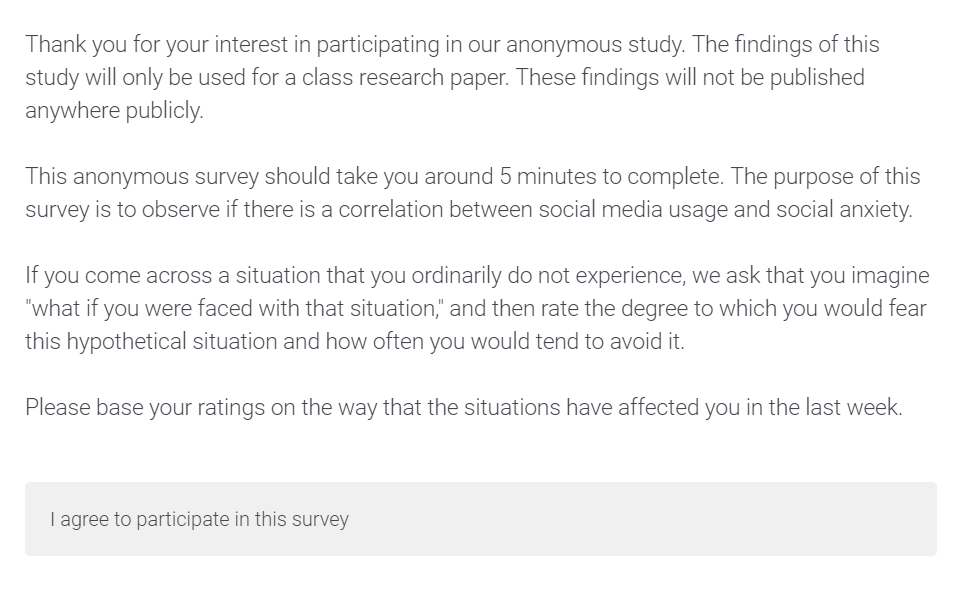
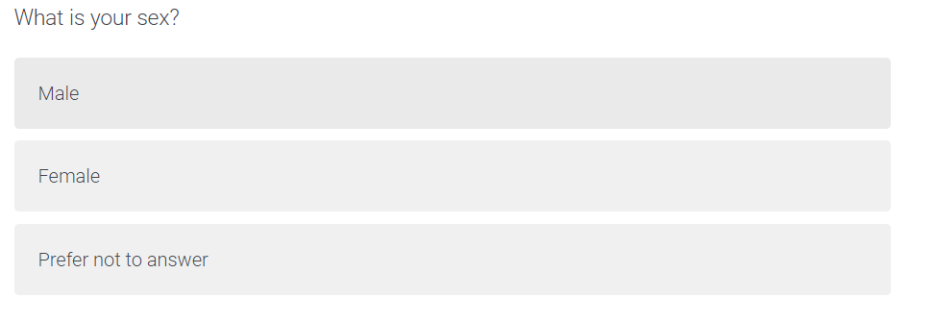
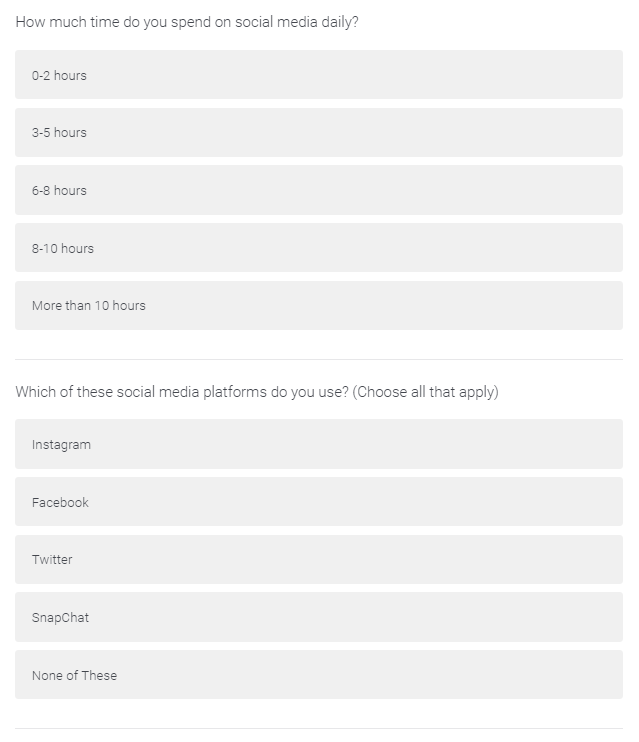
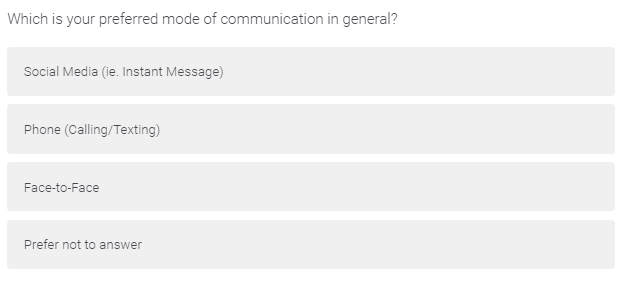
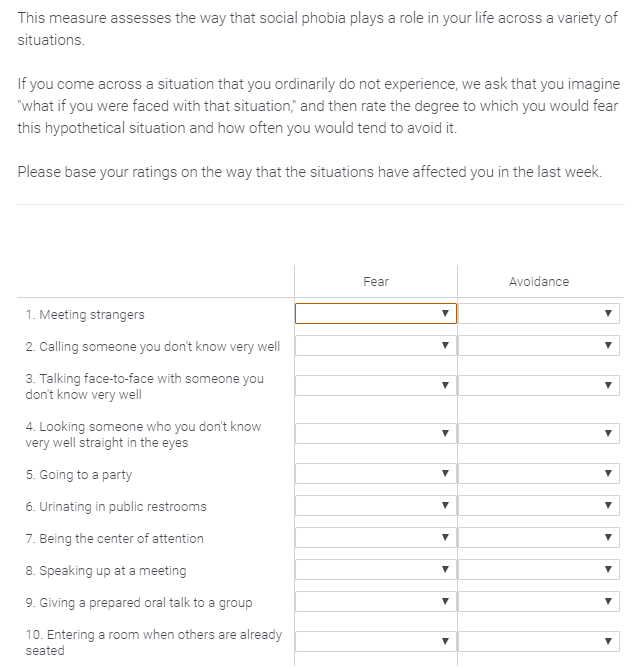
FIG. 5: STANDARD INTERVIEW QUESTIONS
I. Why do you choose [electronic communication/ face-to-face communication] as your preferred medium of communication?
II. Is there any circumstance where you feel online communication would be more appropriate relative to face-to-face communication or vice versa?
III. Within your day-to-day life, when do you feel the most compelled to use electronic communication? Face-to-face?
IV. What do you find most convenient about using [insert medium] to communicate with others? Least convenient? Why?
V. If you are comfortable disclosing this, are there any situations where social anxiety has made you avoid doing something? If so, describe the situation and any steps you take now when encountering similar situations.
6. RESOURCES
Green, T., Wilhelmsen, T., Wilmots, E., Dodd, B., & Quinn, S. (2016). Social anxiety, attributes of online communication and self-disclosure across private and public facebook communication. Computers in Human Behavior, 58, 206-213. doi:10.1016/j.chb.2015.12.066Liebowitz, M. R. (2016).
LIEBOWITZ SOCIAL ANXIETY SCALE. Retrieved from https://nationalsocialanxietyc... style="text-align: justify;">
O’Leary, Z. (2017). The Essential Guide to Doing Your Research Project (3).
SAGE Publications.Pierce, T. (2009). Social anxiety and technology: Face-to-face communication versus technological communication among teens. Computers in Human Behavior, 25(6), 1367-1372. doi:10.1016/j.chb.2009.06.003
